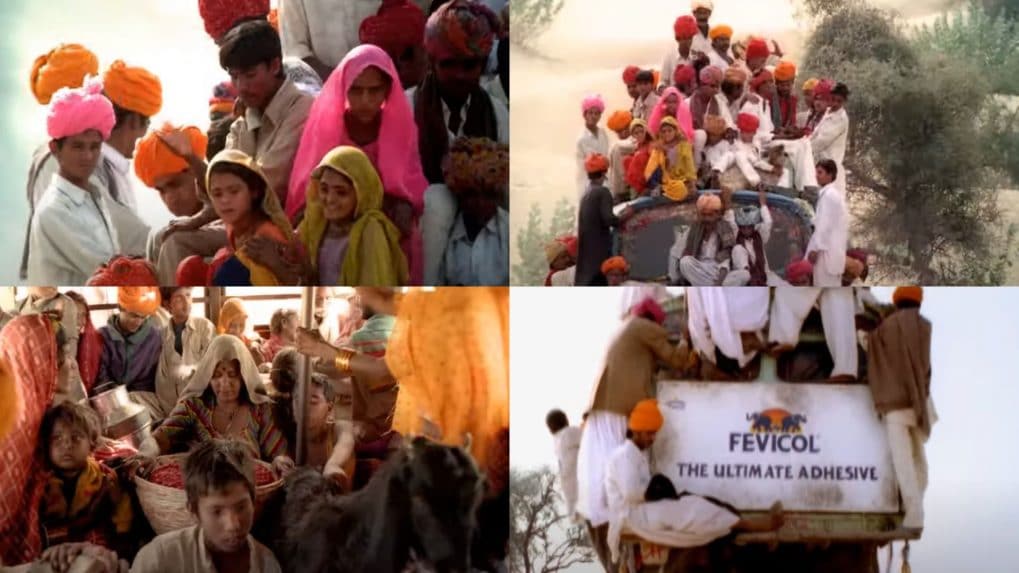When Fevicol ‘Bus’ ad stuck its way to a Silver Lion at Cannes Lions 2002
A rickety desert bus, an inspired filmmaker and a clever twist turned Fevicol’s 2002 ad into a timeless symbol of unbreakable bonds in Indian advertising.
ADVERTISEMENT
The screen opens on a lone Rajasthani man. Soon, the frame widens to reveal others—men, women, children - all jostling in unison, as though part of a strange, synchronized ritual. A rickety bus barrels forward on a desert road, impossibly packed with passengers clinging to every inch of its structure - inside, outside, and atop. The question begs: How are they not falling off?
The answer is revealed, humorously and cleverly, on a small sign affixed to the rear of the vehicle: “Fevicol: The Ultimate Adhesive.”
When this advertisement debuted in 2002, few could have predicted its enduring legacy. Yet over two decades later, it remains etched in the collective memory of Indian viewers, celebrated for its storytelling, symbolism and cultural resonance. Behind the now-iconic film lies a story of creative conviction, logistical hurdles and a filmmaker’s inspired vision.
It began, modestly, with a print ad.
Renowned filmmaker Prasoon Pandey, founder of Corcoise Films, had come across a Fevicol print campaign that depicted a crowded local train with passengers hanging perilously off the sides. Yet, no one fell. A small Fevicol logo at the bottom explained the miracle.
“It was simple. Brilliant,” Pandey recalled in a later interview.
Soon after, Ogilvy & Mather approached him to create a television commercial inspired by the print concept. But Pandey hesitated. Simply translating the idea from print to screen, especially with the same train setting, felt creatively unfulfilling. It took him over a month to commit—only after he found a compelling cinematic alternative.
Pandey drew unexpected inspiration from a 1958 Dutch short film titled Glass, directed by Bert Haanstra. The film, which juxtaposes traditional glassblowing with industrial manufacturing, sparked a thought: what if the ad focused on rhythm, motion and visual buildup?
The train became a bus. The chaos, more exaggerated. “I imagined a road so bad, even a goat would be shaken up,” Pandey said. The visual metaphor was simple: if Fevicol could hold together this chaotic ensemble, it could hold anything.
The commercial was shot over several days in the sand dunes near Jaisalmer. More than 200 local villagers were cast as passengers. But logistical challenges abounded.
“The winter sun travels left to right, so we had to change the bus’s direction every couple of hours,” Pandey explained. To simulate the rough ride, one-foot-deep ditches were dug across the road, but the initial effect was underwhelming. “It looked like a rabbit hopping,” he joked. Alternating the trenches left and right finally delivered the desired bounce.
Then there was the goat. As the story goes, the animal—unimpressed by the film’s artistic ambitions—would urinate on the young boy seated beneath it every time the bus lurched. The crew, Pandey recalled, found it hilarious.
The soundtrack, minimal but evocative, was crafted in collaboration with percussionist Taufiq Qureshi and composer Loy Mendonsa. The goal was not music for music’s sake, but something that could carry the film’s visual rhythm and pacing.
At Cannes in 2002, the ad won a Silver Lion - the first Indian film to win at the prestigious festival in six years. It marked a turning point not just for Fevicol, but for Indian advertising itself.
Piyush Pandey (now Chief Advisor at Ogilvy) was closely involved in the campaign. His creative partnership with Madhukar Parekh, Chairman of Pidilite Industries (Fevicol’s parent company), has become one of the longest-running and most successful in Indian advertising. 'That’s the real Fevicol bond,' they often quip.
Over the years, “Fevicol ka jod” has become a part of the vernacular - a metaphor for relationships, alliances and unbreakable bonds. Even Prime Minister Narendra Modi referenced it during a 2014 visit to Japan, calling India-Japan ties “stronger than a Fevicol bond.”
Fevicol’s advertising strategy has always centered on people, culture and a touch of absurdity. From 1991’s “Dum Laga Ke Haisha” to more recent campaigns, the brand has resisted trendiness in favor of timeless humour rooted in Indian life.
“Some call it retro,” said Piyush Pandey. “I say, we’re not retro, you’re metro. That’s where India lives.”
The Fevicol bus ad was never just about glue. It was about the strength of storytelling and how humor, visual poetry and a touch of absurdity can turn a brand into something mythic.
As Piyush Pandey noted, “An iconic ad isn’t written. You just write the best thing you can. When people fall in love with it, it becomes iconic.”
Read More: How Fevicol egg advertisement was a ‘turning point’ in the brand’s creative journey

